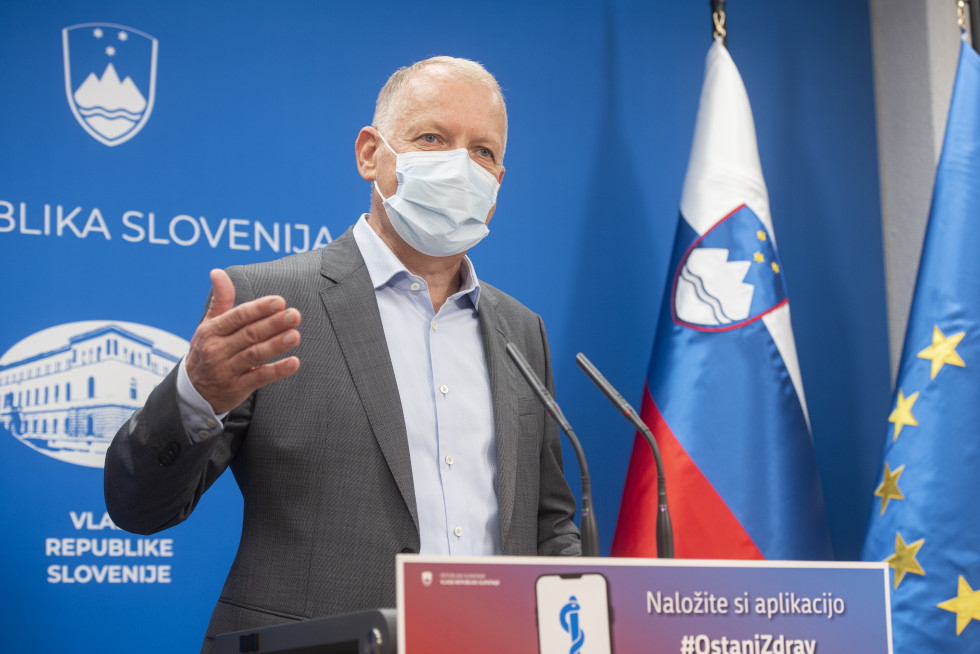Jereb: "The youngest patient in intensive care is a 42-year-old with no underlying medical conditions"
On Tuesday, we recorded the highest number of confirmed cases to date, with 707 out of 4,902 tests carried out coming back positive, meaning that the share of positive tests was 14.4%. Two people died. A total of 210 patients with COVID-19 are currently in hospital, of whom 35 are in intensive care units.
The number of positive cases per 100,000 people in the latest 14-day period is 202, said Mr Kacin. The indicator is highest in the Gorenjska region, with 266 cases per 100,000 inhabitants, followed by the Koroška region with 261 and Central Slovenia with 230, but these figures do not contain today's data about new confirmed cases by region. By comparison, the 14-day incidence rate in Italy is 80 confirmed cases per 100,000 people and in Croatia it is 104, but these statistics are from two days ago.
On Tuesday, 100 cases were confirmed among the residents of Ljubljana, while 38 were confirmed in Kranj, 25 in Domžale, 24 in Radovljica, 19 in Škofja Loka, 18 in Novo mesto, 16 in Jesenice, 15 in Murska Sobota and Velenje, 14 in Grosuplje, Kamnik and Šentjernej, 13 in Mengeš, and 11 in Brežice.
Mr Kacin also presented the different decisions taken by other EU Member States. First and foremost, Member States reached an agreement in principle on recommendations regarding the coordination of measures restricting free movement during the pandemic. The countries agreed that any restrictions of the freedom of movement to protect public health must be proportional, non-discriminatory and temporary, while they have to be removed as soon as the epidemiological situation allows.
It has been decided that countries should plan the adoption of measures 48 hours ahead of their entry into force, if possible, and that the measures should be announced to the public 24 hours prior to their introduction.
Member States have also undertaken to convey their data on the number of new confirmed cases, tests performed and the percentage of confirmed cases per 100,000 people in the last 14 days to the European Centre for Disease Prevention and Control (ECDC) on a weekly basis. Based on these data, a map of the regions in the EU will be prepared and updated weekly. Member States have agreed to a traffic light system according to which regions will be colour coded as green, orange, red or grey.
Mr Jereb said that the analysis of today’s data implied that, in a few days, 10% of today’s cases (i.e. 70 people) would require hospitalisation, of whom 15 will require intensive care treatment. This means that the number of available hospital beds and, especially, adequately trained healthcare professionals are reaching critical levels. More tests are being administered among healthcare professionals, especially in ICUs, where tests will be carried out according to a special timetable, which will increase the possibility of discovering asymptomatic positive cases. Rapid tests are unfortunately not reliable and, in the main, cannot be used.
Mr Jereb emphasised that healthcare professionals will carry out their work according to their conscience and to the best of their abilities, but that they cannot win this fight alone. We can only succeed as a society united. Individuals can help health workers by respecting the preventive measures and, where possible, staying at home and minimising their time in public.
As the hospital beds at the Clinic for Infectious Diseases are starting to run out, new patients will be admitted to the Department of Orthopaedic Surgery. Sixteen patients with COVID-19 who are critically ill, have badly damaged lungs and require a ventilator to help them breathe are currently receiving treatment in the intensive care unit of the Clinic for Infectious Diseases of the University Medical Centre Ljubljana. "No one is safe from COVID-19. The youngest patient in intensive care is a 42-year-old with no underlying medical conditions," stressed Mr Jereb.
Ms Magajne talked about the measures prepared at the Ministry of Health. An injunction restricting some non-essential healthcare services in hospitals was issued. Providers themselves will at least partly be able to decide which non-essential services will still be carried out based on the number of hospital beds and capacities required for patients with COVID-19. Exceptions regarding children and adolescents and, for example, services for the early detection of cancer will apply.
The next measure regulates the introduction of so-called grey zones, where patients for whom it has not yet been determined whether they have COVID-19 can be placed, and the mandatory introduction of red zones, where patients with a confirmed SARS-CoV-2 infection can be placed.
The third injunction establishes that medical students, specialist trainees and those in secondment can be integrated into medical teams.
Ms Magajne also stated that capacities in hospitals across the country are being increased. Topolšica Hospital has not yet been adapted for the admission of patients with COVID-19 as the decision to dedicate it to only treat patients with COVID-19 has not yet been taken.


